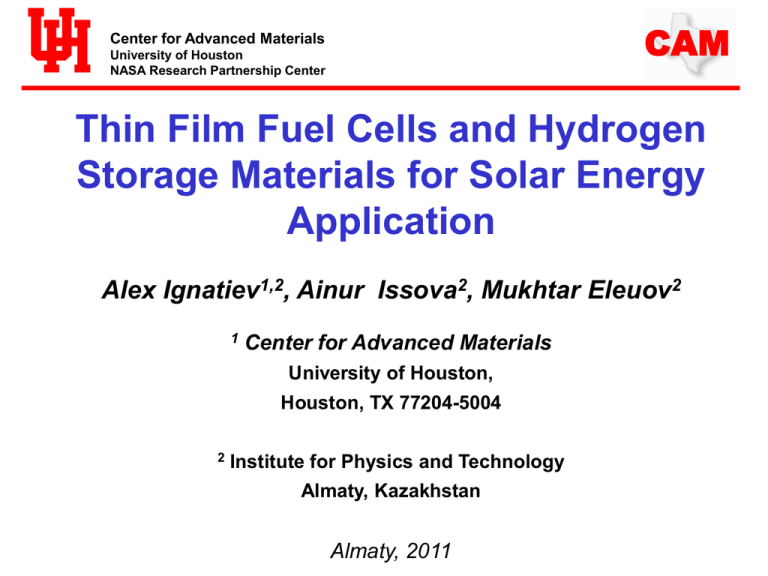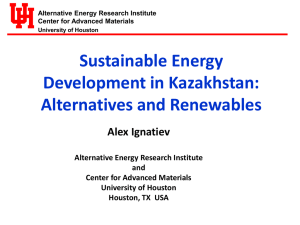Ignatiev
advertisement

CAM Center for Advanced Materials University of Houston NASA Research Partnership Center Thin Film Fuel Cells and Hydrogen Storage Materials for Solar Energy Application Alex Ignatiev1,2, Ainur Issova2, Mukhtar Eleuov2 1 Center for Advanced Materials University of Houston, Houston, TX 77204-5004 2 Institute for Physics and Technology Almaty, Kazakhstan Almaty, 2011 Center for Advanced Materials University of Houston NASA Research Partnership Center Solar Energy Utilization • Sunlight Required • Energy Storage Needed for Nighttime and Cloudy Operation • Store Energy in Hydrogen.. • Electrolyze Water • Utilize Hydrogen Fuel Efficiently CAM Center for Advanced Materials University of Houston NASA Research Partnership Center Hydrogen Storage Options • Liquid • Cold – 22K • 5 wt% - Adequate • EXPENSIVE….. • Gas • High Pressure- 200-500 bar • 2-3 wt% - Too Little Hydrogen • High Pressure Danger • Hydrides • ~ 1 wt% - Too Little Hydrogen in Cycle CAM Center for Advanced Materials University of Houston NASA Research Partnership Center CAM Volume for Storage of 5 kg H2 in Different States (Equivalent to 20 L Gasoline) No Effective way of Storing Hydrogen….. • Polymer Nanostructures…. ?? CAM Center for Advanced Materials University of Houston NASA Research Partnership Center Nanostructured Polymers • Polyanaline Nanotubes • Conducting Polymers • Nanotube pores • High surface area Polyaniline H N H N H N n Polyaniline Nanotubes CAM Center for Advanced Materials University of Houston NASA Research Partnership Center Polyaniline (PANI) Charge & Discharge • Charge at 300psi for 2 hours Torr • Multiple Charge – Discharge Cycles Charged A -6 • Mass Spectrometer Read-out • PANI 2.5-3 wt% H2 Uptake 1.2x10 -6 1.1x10 -6 1.0x10 -7 9.0x10 -7 8.0x10 -7 7.0x10 -7 6.0x10 -7 5.0x10 -7 4.0x10 -7 3.0x10 -7 2.0x10 -7 1.0x10 0.0 •Tested to 12+ Cycles-no deg Charged B Charged E Charged D Discharged B Discharged E Discharged A Discharged D 20 40 • Good Hydrogen Storage and Cycling 60 80 o Temp. C 100 120 140 Center for Advanced Materials University of Houston NASA Research Partnership Center CAM Volume for Storage of 5 kg H2 in Different States (Equivalent to 20 L Gasoline) Polyaniline Polyaniline - Promising Hydrogen Storage System Center for Advanced Materials University of Houston NASA Research Partnership Center Efficient Use of Hydrogen Fuel Hydrogen for Transportation • Internal Combustion Engine • Not Use – Explosive Reaction • Still form NOx • Use Fuel Cell • Electrochemical Reaction • OK - No NOx formed….. • Only WATER…. CAM CAM Center for Advanced Materials University of Houston NASA Research Partnership Center What is a Fuel Cell? A device that generates electricity by combining fuel and oxygen in an electrochemical reaction. 2e- H2O Anode O2- Electrolyte O2- Cathode O2- - H2 Fuel 2e Advantages 1/ O Oxidant 2 2 • High energy conversion efficiency • Minimal environmental impact • Stackable to reach very high power output • Reduced noise level Center for Advanced Materials University of Houston NASA Research Partnership Center Solid Oxide Fuel Cell • Hydrogen and oxygen reactants • ZrO3 electrolyte • Nickel anode • Operating temperature is 900-1000°C • Encapsulation materials challenges • High materials costs • High market cost But, High Efficiency > 60% • How to Reduce market cost …. ?? CAM Center for Advanced Materials University of Houston NASA Research Partnership Center CAM Apply Thin Film Materials Expertise to SOFC Challenges • Develop New Design: Thin Film Solid Oxide Fuel Cell • Thin Film Heterostructure Design - Thin electrolyte- lower temperature operation - Atomically ordered films/interfaces- lower resistance • Microelectronics Processing - Economies of Scale • Lower Fabrication Cost • Smaller Size • Lower Cost Center for Advanced Materials University of Houston NASA Research Partnership Center CAM Thin Film SOFC Heterostructure Growth • Thin Film Atomically Ordered YSZ Electrolyte • Reduce Internal Defects • Reduce Interface Defects • Pulsed Laser Deposition of Epitaxial YSZ Film on Crystalline Nickel Foil Substrate Epitaxial Growth Center for Advanced Materials University of Houston NASA Research Partnership Center CAM Thin Film Heterostructure Solid Oxide Fuel Cell Fuel Ni Foil Anode NOT Porous Nickel Anode ~20mm thick Yttria Stabilized Zirconia Thin Film Electrolyte ~ 0.1 - 1 mm thick Oxygen/Air Total Cell Thickness ~ 20-25 mm thick Porous LaSrCoO3 Cathode ~ 1 mm thick Center for Advanced Materials University of Houston NASA Research Partnership Center CAM Ni Porosity - Microelectronics Photolithography / Etching • Electrochemically Etched Nickel Anode • 60 mm Etched Pores •Nickel Side Electro-etch CAM Center for Advanced Materials University of Houston NASA Research Partnership Center Thin Film Micro SOFC 1.0 120 110 100 0.8 o 570 C 90 o V (V) 70 60 50 0.4 2 0.6 P (mW/cm ) 80 555 C 40 o 520 C 30 0.2 20 o 480 C 10 0.0 0 0 5 10 15 20 25 30 35 I (mA) TFSOFC I vs. V as a Function of Temperature Hydrogen / Air - Polycrystalline Single Cell Center for Advanced Materials University of Houston NASA Research Partnership Center CAM Thin Film Heterostructure SOFC Advancement • Solid Oxide Fuel Cells Have Nickel Anodes • Nickel Excellent Catalyst for Hydrocarbon Reduction • BUT…….‘Coking’ at High Temperatures…. > 600 C • However… Micro Fuel Cell Operates at 500 C – NO Coking…! • Hydrocarbon Fuel Operation at ~60% Efficiency…. • Methane/Methanol • Ethane/Ethanol Center for Advanced Materials University of Houston NASA Research Partnership Center CAM Thin Film Fuel Cell Stack • Require ~ 100V to 200V Operation • Series Connection of Cell Elements • Interconnect Required • Stack Individual Cells Together in Series • Work in Collaboration with Institute for Physics and Technology, Almaty • Advance Technology • Finalize Product •Technology Transfer • Economic Growth CAM Center for Advanced Materials University of Houston NASA Research Partnership Center Thin Film Fuel Cell Stack Components Cell Element Interconnect Fuel Flow Oxidant Flow CAM Center for Advanced Materials University of Houston NASA Research Partnership Center Thin Film Heterostructure SOFC Advancement Fuel Cell Stack Design (In Progress) cathode electrolyte anode TFSOFC Micro-patterned Interconnect Fuel flow Oxidant flow Projected > 5W/cm3 at ~500oC CAM Center for Advanced Materials University of Houston NASA Research Partnership Center Summary • A New Thin Film Solid Oxide Fuel Cell Design • Efficient, Clean, Compact and Cost Efficient • Low Temperature Operation • Direct Use of Hydrocarbon Fuel • Natural Gas • Hydrogen from Dissociation of Water…???? Strategy for Efficient, Clean Electrical Energy Generation Automotive Energy Distributed Energy






